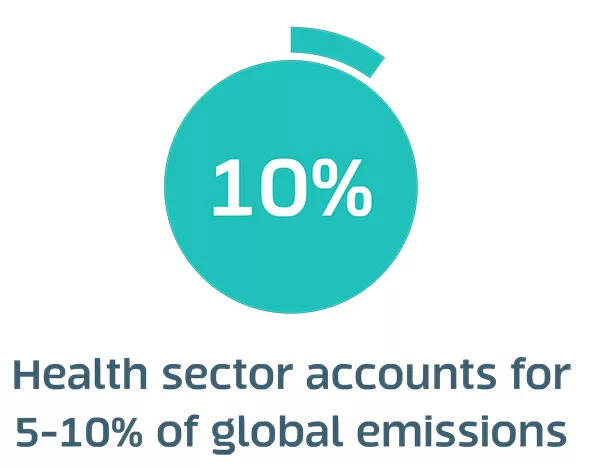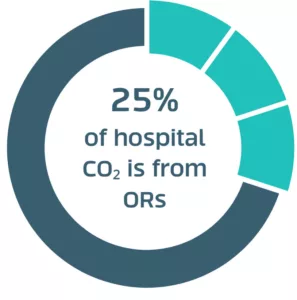Environmental Impact of the Healthcare Sector: A Deep Dive

The healthcare sector, pivotal to the well-being of societies worldwide, unfortunately can have a not-so-healthy relationship with the environment. You can grasp the scale of the issue by looking at the aviation sector, which accounts for 2-3% of global greenhouse gas emissions. Now compare this to the healthcare sector, responsible for almost 5% of global emissions, a figure which can even reach 10% in some high-income nations (1).

The pollution connected to healthcare is also affecting the wellbeing of people, as the damage from pollutants connected to healthcare leads to an annual loss of 405,000 to 470,000 years of healthy life, or so-called disability-adjusted life years in the US (2).
To tackle this challenge, a growing number of countries are taking action as over 80 countries have formally committed to develop climate resilient and low carbon, sustainable health systems (3).
Understanding the Healthcare Sector’s Carbon Footprint
The healthcare sector’s carbon emissions arise from a variety of activities, including the supply chain, energy usage in buildings, transportation, and medical waste disposal.
The World Economic Forum forecasts that if left unchecked, the sector’s CO2 footprint could triple by 2050 (4).
The operating rooms, although a small part of a hospital’s physical footprint, contribute significantly to the total amount of waste generated in the hospital.
These environments tend to be especially energy and resource-intensive, accounting for as much as 25% of a hospital’s total carbon footprint (5).

The Struggle with Waste Management
According to WHO, hospital operating rooms are a major source of waste, producing between 0.2 to 0.5 kg of hazardous waste per hospital bed (6). When looking at the operating rooms, a single surgery may produce up to 12 L of fluid waste, and a typical operating room generates up to 2 tons of fluid waste each month (7).
Although these numbers vary country by country and between surgeries and procedures, it is clear that there are steps to be taken to reduce the environmental impact in healthcare.
The Challenges of Carbon Neutral Healthcare
As the environmental debate expands within healthcare, the impact of material waste and emissions in the operating room is under increased scrutiny. The three pillars of environmental sustainability – reduce, reuse, recycle – are not easily applied in operating rooms. Much of the waste generated in ORs cannot be reused due to safety regulations and hygiene concerns.
As a result, materials reprocessing has become a significant focus for the Food and Drug Administration (FDA), with companies encouraged to innovate next-generation environmentally friendly medical devices (8).
At Serres, we have approached this issue with our Serres Nemo, a surgical fluid disposal device that secures the emptying of the Serres Suction bag in a hygienic manner while significantly reducing the amount of waste generated in the process. With Serres Nemo, hospitals can save up to 97 % CO2e from incineration. For a hospital that uses 10 000 suction bags a year, reductions in costs and CO2e emissions are significant:

To fully understand the environmental impact of our products and find innovative ways to reduce it, we conducted carbon footprint case study calculation on our 2-liter suction bag using a cradle-to-grave approach. You can read more about our. You can read more on our blog post about the CO2e footprint of a 2l Serres Suction bag.
Interestingly, we noticed five main areas where we, together with hospitals, could significantly save on CO₂e emissions. You can read more about these five steps on our blog post.
In addition, we are continuously investigating new sustainable raw materials. To continue being the forerunner in our field, our priority is to reduce and replace fossil-based materials.
Toward A More Sustainable Healthcare Sector
The healthcare sector’s environmental impact is undeniable. However, acknowledging this is the first step toward making a positive change. The sector’s commitment to life and health should not be limited to the human realm but should extend to the health of our planet.
By identifying and tackling the sources of its emissions and waste, the healthcare sector can lead by example and help foster a healthier and more sustainable world.
——————————————————
1) Climate change and health: three grand challenges | Nature Medicine
2) Hidden harm: US healthcare emits more greenhouse gas than entire UK | Reuters
3) Country commitments to climate change and health (who.int)
5) Cultivating sustainability in NBT’s operating theatres | North Bristol NHS Trust
6) Health-care waste (who.int)
7) People, planet and profits: the case for greening operating rooms – PMC (nih.gov)
8) https://www.ncbi.nlm.nih.gov/pmc/articles/PMC7351340/


